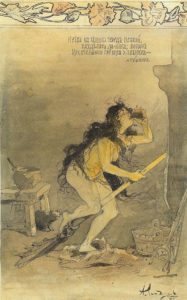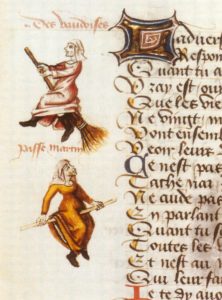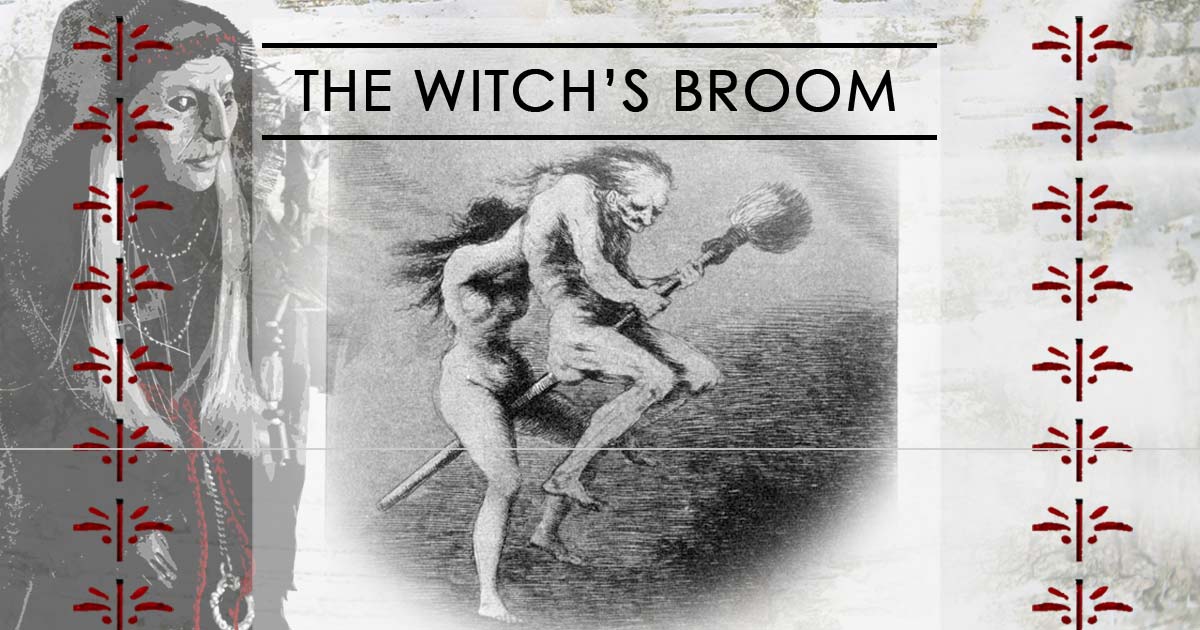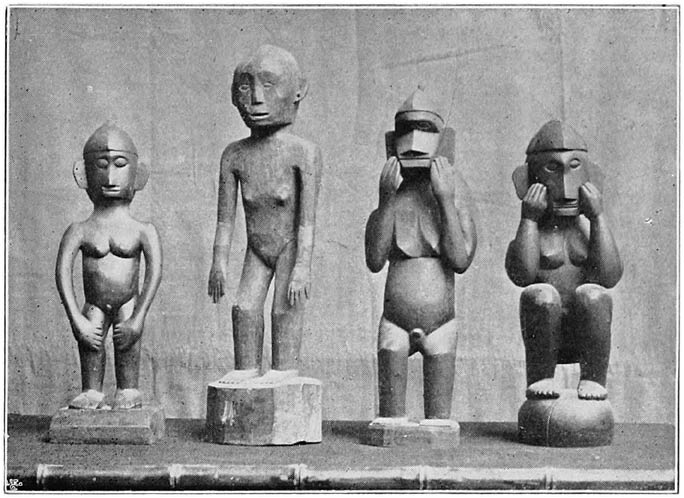
Francisco Goya’s 1799 print “Los Caprichos” depicts the broom as a magical vehicle traditionally believed to carry witches or wizards to the Sabbath.
The besom, broom, or broomstick is an ordinary household tool, crafted to sweep floors, hearths, and yards in order to keep domestic spaces clean. In agrarian life, sweeping had a magical function, as clearing away dirt and debris symbolically marked the boundary between the cultivated home and the wild forces of nature. Over time, this magical function expanded. In the hands of a witch, the ordinary broom transforms from a housekeeping tool into a magical object that sacralizes space.

Artemisia absinthium (Wormwood) from Thome’s “Flora von Deutschland, Österreich und der Schweiz” (1885) is used by Romanian women to make protective magical besoms on Marina’s Day.
Between the domestic and the wild
In more recent European folklore, the broom was imagined as the vehicle by which witches could cross those boundaries between the domestic and the wild, sometimes physically, more often spiritually. Stories of witches riding on brooms to their secret nocturnal gatherings, or sabbaths, reinforced this belief.
These beliefs and stories were inspired by ancient accounts of nocturnal spirit flights, such as the ecstatic night-flying experiences associated with goddesses and female spirits. Even earlier, throughout Eurasian shamanic traditions, shamans were believed to send their spirits on journeys at night, travel to other realms, or retrieve knowledge and power from the Otherworld. These visionary flights often involved trance states and hallucinogenic substances, and sometimes the shaman was imagined to ride an animal, such as a horse, wolf, or other creature.
This conflation of the domestic broom with the nocturnal spirit flight reflects a cultural anxiety about the witch, a figure of supernatural power and thus a symbol of the insidious intrusion of chaos into the domestic sphere. Just as the broom swept away dirt and maintained order, its magical counterpart became the instrument through which disorder and wild forces could penetrate the home.

Anton Kandaurov’s 1899 illustration of a Pushkin fairy-tale witch: “And she stood on the broom in front of the stove, naked; then she performed three turns and drank ‘khlebnula’.”
Symbol of the domestic goddess
In Ancient Roman tradition, Deverra, whose name comes from the Latin deverro, meaning “to sweep away”, was one of three deities who protected midwives and women in labor, alongside Pilumnus and Intercidona. Deverra was represented by a broom in charms against Silvanus, the god of the woods, and she also oversaw the brooms used to cleanse temples before sacrifices, worship, and other religious celebrations.
Romanian folk magic inherited much from Roman tradition, and the apotropaic function of the broom is no exception. For example, on Marina’s Day (July 17), mothers honor Marina, the protector of children’s souls, by making brooms from wormwood (Artemisia absinthium), often gifting them with flowers, corn, and chicks.
Like Deverra, Marina is associated with protection, particularly of the vulnerable, such as children. The wormwood brooms are believed to sweep away not only dirt but also misfortune and harmful spirits. They were placed near a child’s cradle or at the home’s threshold to protect against supernatural threats, including the Mother of the Forest. The broom was commonly used in charms against the Mother of the Forest, the same way it was used in charms against Silvanus. Both woodland deities were believed to cause harm and frighten children, and the broom was one of the objects that kept them from entering the household.
The broom as a household spirit

Hexenflug of the “Vaudoises” from Martin Le Franc’s 1451 Ladies’ Champion is believed to be the first illustration of women flying on a besom, depicting witches as distinguished from ordinary women solely by this ability, unlike other contemporary manuscripts that showed them as deformed.
Across the Balkans, the broom was considered a living presence in the home, a protective household spirit charged with maintaining order. Therefore, it was surrounded by taboos and had to be handled with care. Breaking a broom, misusing an old one, or discarding it carelessly was thought to invite misfortune. Old brooms were stored carefully in attics or with other household objects, never left near the house or on the road, for stepping on one could bring illness. Burning a broom in the hearth was likewise forbidden, as it was believed to call upon storms, fierce winds, or other natural disasters.
The broom’s protective power was especially evident in caring for the most vulnerable. Families placed brooms near the cradle or bed of a newborn to shield the child from malevolent spirits and nightmares, particularly before baptism. The paths of newlyweds were swept clean to remove potential spells cast by witches, while the broom could even be thrown at someone suspected of casting the evil eye. As such, the broom was akin to a guardian that defended the household from unseen forces that threatened domestic harmony.
Its protective influence extended to everyday life and daily crises. During fires, brooms were held or placed in the corners around the home to contain danger. Livestock might step over a buried broom to ward off disease, and hanging a broom in a barn could protect livestock and young chickens from predators. When handling a broom, it was important to do so carefully and avoid striking or sweeping over the feet of a child or animal, as it was believed that it could stunt growth, bring misfortune, prevent marriage, or harm the creature.
The broom was also a significant tool in therapeutic and ritual magic. For instance, when a child cried incessantly at night, an old broom might be thrown out the window along with the child’s clothes, to symbolically sweep away the cause of the distress. In other rituals, the child would be “swept” from head to toe and gently struck on the threshold to transfer the harm away. During epidemics or livestock outbreaks, it was used in ceremonies intended to cleanse and defend the village. When someone died of cholera, for example, the spouse of the deceased would sweep the path of the coffin to the cemetery, ritually removing malevolent forces from the route.
Sweeper of seasons
Folklore holds that brooms made on special feast days, such as Marina’s Day (July 17), but also Arminden (May 1st), St. George’s Day (April 23rd), or St. John’s Day (June 24th), carry sacred, fertile, and protective powers. These days marked moments of transition in the folk calendar, when the boundaries between the human world and the spirit world were especially thin, and when vegetation was thought to overflow with life force.
Cutting branches and making brooms from green wood on such days meant that the broom embodied not only the strength of the tree but also the presiding divinities. Furthermore, such moments of transition were a time of renewal. Just as the old was swept clean and begun anew, so too could the broom sweep away sickness, evil, and decay, clearing space for fertility, growth, and protection. Because of this, brooms became apotropaic objects for warding off harmful spirits, witches, or disease.

www.Nettlesgarden.com – The Old Craft






Carol | May 16, 2019
|
I am so glad that I found your site I have been wanting to make my own besom , and I love the ritual to remove negativity . this is just so awesome, thanks
Sherrie Lieber Pasarell | May 19, 2019
|
Thank you~
Mary | August 17, 2019
|
I am moving to a new home and am having a new besom sent to the new house. My question is what to do with the old besom. It has served me for 10 years and I don’t think the new homeowners are going to appreciate me leaving the broom behind. And I’m not sure I want to leave it for them since it’s my magical object. Is there a proper way to dispose of the old besom?
Alexander | August 17, 2019
|
Hi Mary,
you never should leave magical objects of yours behind or give them to someone else. If you leave a place, you should take the magical forms, energies and loades objects with you to your new place. Especially the besom is easy to move, and there is no reason why you shouldn’t have two.
If for some reson you cannot move a loaded object (for example it was the room or the space/house itself you loaded), then you will need to *unload* (and maybe transfer) it.
This can be done obviously also with a movable object, such as a besom if you still insist on giving it up: unload it and take back, what you put into it. Only after this is entirely done, you should part from it.
Despite unloading, I usually would not recommend passing it to someone else.
Best
S.
Tracey | November 18, 2019
|
Thanks for this ad ice and Information I am a witch that’s very young as in learning about my craft, I am having my handfasting next summer solstice 20/06/2020 and I have never made my besom, but I am as I want my own broom to jump, so you have given me even more reason to make my besom ?♀️?♀️?♀️?♀️?♀️
Yamaya | October 4, 2020
|
I made a besom that I love. I have moved and brought it with me. I really don’t want to depart from it. So, I was going to cleanse it with sage and holy water and add more decorations on it. Do you think this it a good idea? I am also going to make another one to place in my new place. Do you think this a good idea?
Dotte | July 18, 2021
|
Hi- I love this site. How can I sign up for newsletters/updates? Thank you!
Kim Gill | October 2, 2025
|
67 year old Australian witch, looking for new spells and a new broomstick